

LatentView Analytics Corporation
Oscar Success Prediction. Big Data Analytics. Procedure: QuickBooks Online product was compared with QuickBooks Desktop, Xero, FreshBooks, Sage and Wave for the ratings, usage of the products across different industry verticals and company sizes.
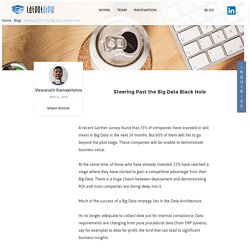
The reviews from g2crowd.com were scrapped using Python, along with the details of the reviewer such as role, experience, industry information, size of company and, likes and dislikes for the product. G2crowd.com identified the industry verticals and classified the size of the company based on the user information provided on their respective LinkedIn accounts. Representation: The ratings were on a scale of 1-5. Consumer Behavior. Charting the IoT Opportunity As the Internet of Things (IoT) gains momentum, it’s apparent that it will force change in nearly every industry, much like the Internet did.
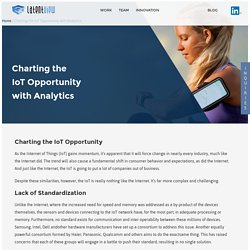
The trend will also cause a fundamental shift in consumer behavior and expectations, as did the Internet. And just like the Internet, the IoT is going to put a lot of companies out of business. Despite these similarities, however, the IoT is really nothing like the Internet. It’s far more complex and challenging. Time-series forecasting. Observation: The data obtained was the analysed to see where these products were predominantly being used.

Data Analytics Trends. What trends should data analysts be paying attention to this year?
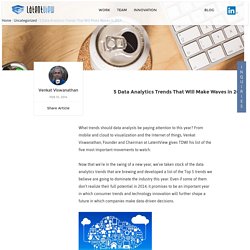
From mobile and cloud to visualization and the Internet of things, Venkat Viswanathan, Founder and Chairman at LatentView gives TDWI his list of the five most important movements to watch. Now that we’re in the swing of a new year, we’ve taken stock of the data analytics trends that are brewing and developed a list of the Top 5 trends we believe are going to dominate the industry this year. Even if some of them don’t realize their full potential in 2014, it promises to be an important year in which consumer trends and technology innovation will further shape a future in which companies make data-driven decisions.
Predictive Modeling. In order to provide accurate digital insights that are representative of the browsing population across devices, companies are increasingly looking to collect consumer behavior data from multiple sources.

They then look to blend those sources into a single digital panel, and use algorithms and advanced analytics techniques to normalize the data to the population as a whole. Digital panels track every click of the panel member, search key words and can help understand path to purchase better (either in their digital property or at competitors property). Predictive Analytics. Modern Marketer’s fascination with mobile is not new – the power of this channel has been measured, analyzed and talked about for quite some time now, and the focus is certainly not going away.
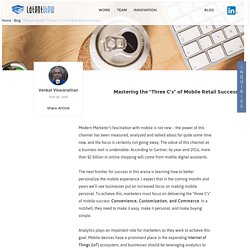
The value of this channel as a business tool is undeniable. According to Gartner, by year-end 2016, more than $2 billion in online shopping will come from mobile digital assistants. The next frontier for success in this arena is learning how to better personalize the mobile experience. I expect that in the coming months and years we’ll see businesses put an increased focus on making mobile personal. To achieve this, marketers must focus on delivering the “three C’s” of mobile success: Convenience, Customization, and Commerce. Unstructured Data Analytics. Businesses are well aware that analytics is changing everything – and that the difference between simply surviving or thriving, hinges on how they interpret and utilize data.
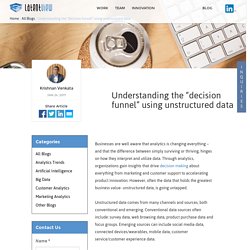
Through analytics, organizations gain insights that drive decision making about everything from marketing and customer support to accelerating product innovation. However, often the data that holds the greatest business value- unstructured data, is going untapped. Unstructured data comes from many channels and sources, both conventional and emerging. Conventional data sources often include: survey data, web browsing data, product purchase data and focus groups. Emerging sources can include social media data, connected devices/wearables, mobile data, customer service/customer experience data.
Combining the information from all of these sources gives a company a critical view of how customers perceive its brand and how the business is stacking up against competition. Social Media Analytics. Being an analytics professional, I like doing interesting analyses on various hypotheses I have regarding what is going on in the world.

Most recently, I’ve been thinking about how there is a mismatch between what the businesses portray and what the consumers actually feel about brands. To test this hypothesis, I analyzed 100,000 tweets of four brands: Sears, Wal-mart, Kroger and Macy’s. And the findings are in line with the hypothesis. Consumers have a very specific impression of each brand which is the sum total of all the marketing efforts and in-store experiences e.g. we can see below in the first chart that Sears has a very distinct impression compared to other retailers.
Analytics Processes. In this first post of a brief blog series, we’ll take a broad view at how organizations, such as your own, can assess analytics maturity and what they can do to move up the maturity curve faster (and ultimately, apply analytics to do everything from drive operational efficiencies, expedite product innovation and enhance consumer experience, to boost financial performance).
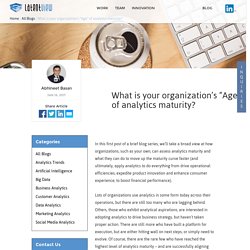
Lots of organizations use analytics in some form today across their operations, but there are still too many who are lagging behind. High Net Worth Customers. In the halls of marketing fame, customer acquisition stories get all the attention while those involving retention are rarely discussed with the same fervor and enthusiasm.
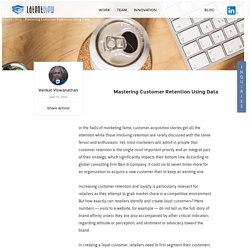
Yet, most marketers will admit in private that customer retention is the single most important priority and an integral part of their strategy, which significantly impacts their bottom line. According to global consulting firm Bain & Company, it costs six to seven times more for an organization to acquire a new customer than to keep an existing one. Increasing customer retention and loyalty is particularly relevant for retailers as they attempt to grab market share in a competitive environment. Optimal Analytics Maturity. Note: Krishnan Venkata, Vice President- US West presented a paper on ‘A Roadmap for Optimal Analytics Maturity’ at the Chief Data And Analytics Officers Exchange in California, early this year.
A summary of his presentation is captured in this blog post. We’re often asked by our customers what the ideal roadmap to analytics maturity is. Like with most great questions, there is no single right answer. There are multiple factors that need to be evaluated, measured and understood in relation to each other. The Davenport Delta Model lays out a simple but comprehensive framework to measure analytics maturity. Figure 1: Primary success factors in attaining analytics maturity. Chat with Jeroen Tas, CEO, Connected Care & Health Informatics. Very rarely do you see CEOs that also have a CIO background. Using Analytics To Drive Innovation. Innovation at Whirlpool is not new. We have been going down that path for some time now. Conversation with Bas Spierenburg, Marcus Hartmann, Sascha and Blake. In this interactive panel discussion, the panelists and participants exchange ideas and insights into how they and their organizations use data to prepare for a digital future and the challenges they face.
Here are some sound bites from the discussion. “We have realized that there is a lot of potential in digitization and technology. We see a lot business models that transform the organization from a traditional product manufacturer to a service provider.”- Sascha Vukovic, Corporate Planning and Product Strategy – Strategy Digitalization, BMW “Using data, we can see how people are moving between different digital touchpoints.
It gives us really valuable insights into how customers are using various touchpoints and in what phase of their consumer decision journey they are in each of them.”- Bas Spierenburg, Global CRM and Mobile Manager, AkzoNobel. Customer Lifetime Value. Customer Lifetime Value (CLV) is the estimated net profit a business expects to get from the entire duration of its relationship with a customer. A high CLV is desirable as it implies increased profits and higher levels of customer engagement. Analytics is today used by mature organizations across the different stages of the customer lifecycle in order to increase CLV.
Chewing Gum Usage in USA. High Net Worth Customers. Survey Form – Latent View. List of The Top 12 Books That Are Guaranteed To Make You Laugh. How Can You Use Data to Rethink the Customer Journey?